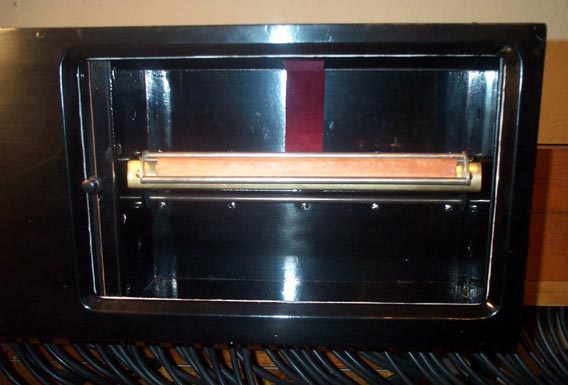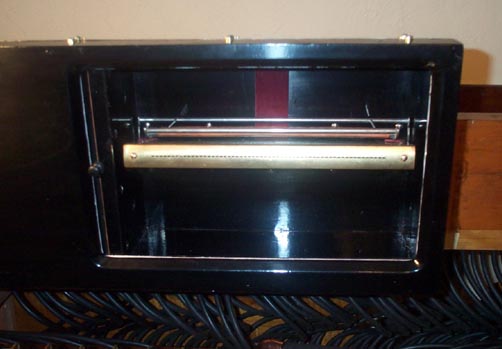Chapter 15.2 - The Spoolbox Tracker Bar Cover
The "flipper" that covers the tracker bar when the player is not in use, is important. When the primary circuit is "inflated" by the valve in the manual touchbox, the path to atmosphere through the still connected tracker bar port, must be closed. I once thought that the spool box was always pressurized when ever the door was closed, and the pressure would push the flipper leather against the tracker bar. But Kevin McElhone corrected me; when the organ is turned to "Pneumatic to Manual" (which turns on the keyboard, and shifts the transmission to reroll) a valve linkage, missing on my organ, shuts off the wind to the spoolbox. Therefore, the flipper must be designed to block the tracker bar ports by its own weight and shape. The drawing shows the cross section of the flipper, with the thickness of the leather exaggerated for clarity. The flipper consists of a frame that swings forward and down, and four crossbars. An arrangement of felt and leather is stretched between the two smaller crossbars, such that the felt is curved just enough to push the leather against the tracker ports, by the weight of the frame alone.
Of course the leather on mine was rotten and torn, and had to be replaced. After several trials (and some wasted pouch leather), I figured out a way to do this. The original leather was very thin and soft, but it was darker than pouch leather; something like the thin skiver that used to be used to line the covers of leather bound Nelson pocket editions. I decided to try pouch leather (someday I will get around to getting some shoe dye, to make it dark brown). The original felt core was 5/8" wide, the same as modern name board felt. A composite of two pieces of the thickest, and one piece of the thinnest name board felt, made a strip that matched the original in thickness and softness.
A good piece of pouch leather was stuck down very flat, on a fresh cutting board, made sticky with Spray Mount. One edge of the leather was trimmed in a straight line, and all but 1/2" at the edge was masked off, and the felt strip was hot glued here. A piece of aluminum bar kept the felt straight for gluing. Now keeping the leather flat and clean as the strip was threaded around the bars proved to be a problem. But this worked for me. On the opposite edge of the leather strip (cut wider than it will end up being), a sheet of paper was stuck on with Spray Mount.
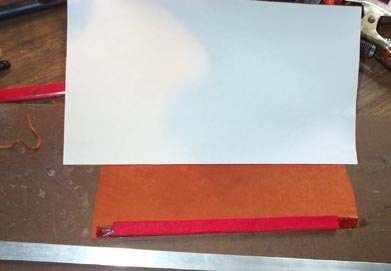
The whole thing was trimmed to width, and a pointed "leader" was cut in the paper. Now this point can be threaded through the narrow gaps between the bars, and the leather pulled tight and even by tugging the paper.
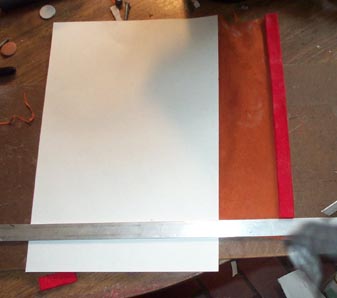
First, the felt strip was "snapped" between the small bars from the back, and the leather was threaded through between the two lower bars. The leather was folded forward over the lower small bar (towards the side where the tracker bar will touch). Then the leather was turned up over the felt and threaded back "out" between the upper bars. Now the leather was wrapped smoothly, but not too tightly, over the tracker bar side of the felt.
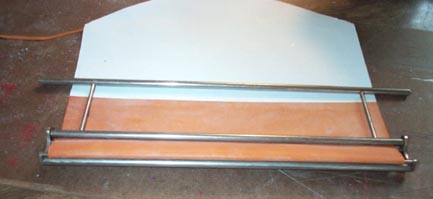
The assembly is turned over, and the edge of the leather is ready for the second glue joint. Using a small brush, a thin line of glue is run along the back of where the first edge of the leather was glued to the felt, and the free end is pasted down. Don't try to thread the free end through the lower gap again; that will just pull everything cattywumpus.
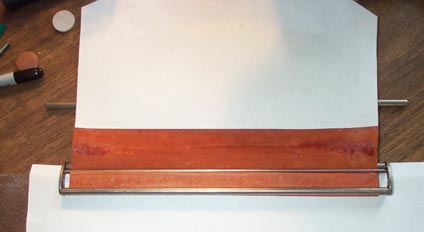
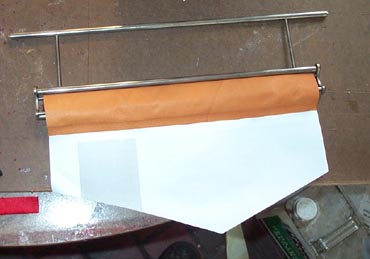
When this has set, tuck the excess under the big lower bar, and very carefully run a sharp blade along this cut, to trim off the extra. This final cut will not show, ending up behind the large bar at the bottom.
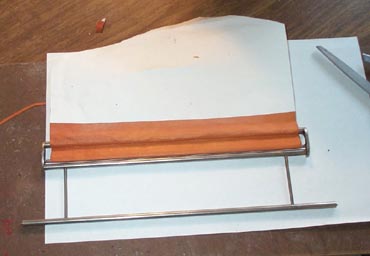
Where the hinge bar comes out of the box on the right side, there must have been some sort of linkage; a little lever arm is screwed in there. I have no idea what it was for. But there should be a way to adjust how far forward the assembly can go, to optimize the angle at which the flipper rests over the bar. An eccentric was made out of 5/8" dowel and action cloth. By turning the eccentric, the movement of the link lever can be limited as required to set the forward movement of the bar. Another eccentric is installed, to pad the rearward movement, so that the levers don't bang against the rear of the spoolbox when folded back.
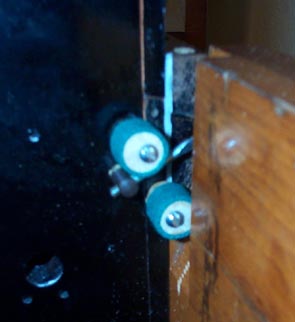
The removable assembly snaps into place by spreading the lever arms on the main rod.
This is what it looks like, deployed and stowed away.
